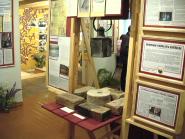Articles
/
"Red Pathfinders", a local history study movement
"Red Pathfinders", a local history study movement
Subject /
Local studies
"Red Pathfinder" is a local history study movement. It has arisen in the second half of the 1960s among school-children and students. The newspaper "Leninskiye Iskri" ("Lenin's Sparks", L.) became the initiator of the movement, later it became an all-union movement. "Lenin rooms", the Battle Glory Museums were founded at schools, camping expeditions to battle places were held, "Memory watches" were organized, searching decedent soldiers and their relatives was carried out. So, "Red Pathfinders" of the Boksitogorsk secondary school No. 1 (now it is MOU (Municipal Educational Establishment) "Boksitogorsk High School") have searched for about 700 relatives of desedent soldiers, a museum was founded on the base of the school. One of Boksitogorsk Town's streets was called after Red Pathfinders. The movement has the direction occupied with searching remains of Soviet soldiers perished during the World War II and immortalizing them. In the 1980s the other population groups took active part in the movement too. The firest All-Union assembly of searching groups leaders was organized in Kaluga Town in the 1980s and the Coordinating Board headed by Yu.M. Ikonnikov was created. From 1989 the searching movement obtained the official recognition, bit by bit the state agencies of the Russian Federation began to appropriate funds to searchers for expeditions. The Law of the Russian Federation "About the Perpetuation of the Memory of the Deseased at the Defence of the Fatherland" was passed in 1993. The searching actions were attached the state status and they were begun to finance from the federal budget and budgets of subjects of the Russian Federation. The Public Fund "Searching Groups of the Leningrad Oblast" headed by I.G. Prokofyev was created in 1994. Every year several tens searching groups from various regions of Russia works in the Leningrad Oblast at present time. In all more then 800 thousand soldiers have perished on the oblast territory, only 530 thousand soldiers were buried officially. Searches are carried out at places of the most fierce and long battles: in the region of the Sinyavino Heights, on "Nevsky Pyatochok" ("Nevsky Spot"), in the reegion of Lyuban Town. During 1994-2005 remains of more then 33 thousand Soviet soldiers were found in the Leningrad Oblast, names of more then 3, 500 perished soldiers were ascertained. Only in 2005 more then 4 thousand perished soldiers were found. Annual "Memory watches" devoted to the Victory anniversaries are coninued to hold. In winters searchers work in archives, they determine regions where the most intense battles were. At the places of battles simultaneously with "Red Pathfinders" illegal dig is gone on by so -called "Black Pathfinders" who purpose generally commercial aims.
Authors
Yegorov, Sergey Borisovich
Persons
Ikonnikov, Yuli Mikhailovich
Prokofyev, Ilya Gennadyevich
Geography
Leningrad Oblast, the/Boksitogorsk District/Boksitogorsk Town/Krasniye Sledopyti (Red Pathfinders) Street
Leningrad Oblast, the/Tosno District/Lyuban Town
Topographical landmarks/Nevsky Spot
Topographical landmarks/Sinyavino Heights, the
Bibliography
Калинин М.А., Федяев А.И. Бокситогорск – Пикалево. Л.. 1983., С.74
Группа военной археологии Искатель. URL: http://www.1942.ru/poisk.htm, С.74
Страницы истории Бокситогорского района. URL: http://bxt.lokos.net/pobeda, С.74
Поисковое движение в России. URL: http://www.adventure.ru/kis/03-2001/gsp.shtml, С.74
Mentioned in articles:
|
hidden
|
School museums
School museums began to establish in the Leningrad Oblast between 1950 - the 1960s in connection with developing the local history studing, heroic and patriotic and environmental movement among school children. Teachers of history and geography... more
|
|
|
|
hidden
|
Studing the local history of the Leningrad Oblast.
Studing the local history of the Leningrad Oblast. The interest for studing the history, culture, geography of single regions and towns, which were included in the Leningrad Oblast now, became apparent from the middle of the 19th century among ... more
|
|
|
|






